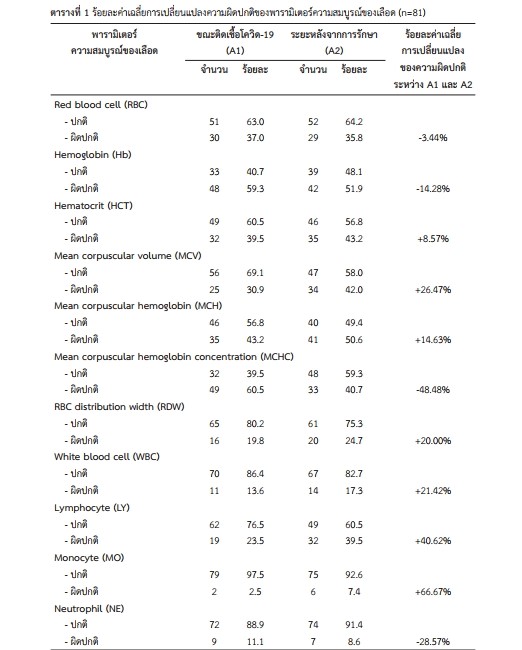การเปลี่ยนแปลงค่าความสมบูรณ์ของเลือดในขณะติดเชื้อไวรัสโคโรนา 2019 และหลังจากการรักษา ในกลุ่มผู้ป่วยโรคไม่ติดต่อ เขตมาบตาพุด จังหวัดระยอง
คำสำคัญ:
โควิด-19 , ความสมบูรณ์ของเลือด , ผู้ป่วยโรคไม่ติดต่อ , มาบตาพุดบทคัดย่อ
การศึกษาเชิงพรรณนาครั้งนี้ มีวัตถุประสงค์เพื่อศึกษาการเปลี่ยนแปลงค่าความสมบูรณ์ของเลือดและเปรียบเทียบค่าความสมบูรณ์ของเลือดระหว่างในขณะติดเชื้อโควิด-19 และหลังจากการรักษา ในกลุ่มผู้ป่วยโรคไม่ติดต่อ ที่เข้ารับการรักษาในโรงพยาบาลและโรงพยาบาลสนามแห่งหนึ่งในพื้นที่มาบตาพุด จังหวัดระยอง จำนวนกลุ่มตัวอย่าง 81 ราย เครื่องมือที่ใช้ในการวิจัยเป็นแบบสัมภาษณ์และการเก็บตัวอย่างเลือด เพื่อวิเคราะห์ความสมบูรณ์ของเลือด ได้แก่ เม็ดเลือดแดง เม็ดเลือดขาว และเกล็ดเลือด โดยการรวบรวมข้อมูลเป็นการเก็บข้อมูลซ้ำ 2 ครั้งในผู้ป่วยรายเดียวกัน ซึ่งครั้งที่ 1 เก็บตัวอย่างเลือดในวันแรกที่ทดสอบด้วยชุดแอนติเจนพบเชื้อโควิด-19 และรับเข้าการรักษาในโรงพยาบาล และเก็บครั้งที่ 2 ในวันที่แพทย์อนุญาตให้กลับบ้านได้โดยทดสอบแอนติเจนไม่พบเชื้อโควิด-19 วิเคราะห์ข้อมูลด้วยการคำนวณร้อยละการเปลี่ยนแปลง และวิเคราะห์เปรียบเทียบด้วยสถิติ Paired sample t-test
ผลการศึกษาพบว่า ในขณะติดเชื้อผู้ป่วยมีความเข้นข้นของฮีโมโกลบินในเม็ดเลือดแดงผิดปกติมากที่สุด ร้อยละ 60.5 หลังจากการรักษาพบความผิดปกติลดลงเหลือร้อยละ 40.7 ซึ่งมีการเปลี่ยนแปลงร้อยละ 48.5 รองลงมาพบความผิดปกติของฮีโมโกลิบินในเม็ดเลือดแดงและฮีโมโกลบินร้อยละ 59.3 และ 43.2 ตามลำดับ สำหรับผลการวิเคราะห์เปรียบเทียบพบว่า ในขณะการติดเชื้อโควิด-19 ผู้ป่วยมีค่าเฉลี่ยของปริมาตรของเม็ดเลือดแดง ฮีโมโกลบินในเม็ดเลือดแดง เม็ดเลือดขาว ลิมโฟไซต์ อิโอซิโนฟิล และเกล็ดเลือดเพิ่มมากขึ้นกว่าหลังจากการรักษาอย่างมีนัยสำคัญทางสถิติ (p < .05) อย่างไรก็ตามในทิศทางตรงกันข้าม ในขณะการติดเชื้อ ผู้ป่วยมีความเข้นข้นของฮีโมโกลบินในเม็ดเลือดแดง การกระจายตัวของขนาดเม็ดเลือดแดง โมโนไซต์ และนิวโทรฟิล ลดลงกว่าหลังการรักษาอย่างมีนัยสำคัญทางสถิติ (p < .05) จากผลการวิจัยมีข้อเสนอแนะว่า ความสมบูรณ์ของเลือดมีการเปลี่ยนแปลงในขณะที่มีการติดเชื้อโควิด-19 โดยเฉพาะเม็ดเลือดขาวซึ่งเป็นการตอบสนองของภูมิคุ้มกันตามธรรมชาติของร่างกาย ดังนั้น การเฝ้าระวังผลกระทบต่อสุขภาพผู้ป่วยควรได้รับการติดตามปริมาณเม็ดเลือดขาวเป็นสำคัญ
เอกสารอ้างอิง
Ali, N. (2021). Relationship between COVID-19 infection and liver injury: A review of recent data. Retrieved from https://doi:10.3389/fmed.2020.00458
Anurag, A., Jha, P. K., & Kumar, A. (2020). Differential white blood cell count in the COVID-19: A cross-sectional study of 148 patients. Diabetes & Metabolic Syndrome: Clinical Research & Reviews, 14(6), 2099-2102.
Bunsarai, A., Polyong, P. C., Pairpiroon, S., & Konsombatsuk, M. (2022). Comparison of blood biochemical levels in NCDs patients receiving anti-infective novel coronavirus disease-2019 drugs, Map Ta Phut district, Rayong province. Thai Journal of Health Education, 45(1), 102-113. [in Thai]
Chailak, P., & Sunongbua, A. (2021). The outcome of diabetic patients cares during the prevention of covid-19 pandemic situation at Mueang Chaiyaphum primary care unit, 2020, Chaiyaphum Medicine Journal, 41(1), 111-121. [in Thai]
CSSEGIS and DATA. (2022). COVID-19 data repository by the center for systems science and engineering (CSSE) at Johns Hopkins University. Retrieved from https://github.com/CSSEGISandData/COVID-19
Deeruksa, L., & Sanchaisuriya, K. (2017). Anemia in the elderly in Northeastern Thailand: A community-based study investigating prevalence, contributing factors, and hematologic features. Acta Haematologica, 138(2), 96-102.
Ekburanawat, W. (2017). Interpretation of complete blood count results. Retrieved from https://www.summacheeva.org/article/cbc ([in Thai]
Güçlü, E., Kocayiğit, H., Okan, H. D., Erkorkmaz, U., Yürümez, Y., Yaylacı, S., Koroglu, M., Uzun, C., & Karabay, O. (2020). Effect of COVID-19 on platelet count and its indices. Revista da Associacao Medica Brasileira, 66(8), 1122-1127.
Hansomboon, P. (2021). Medical expenses for COVID-19. Journal of The Department of Medical Services, 46(1), 5-9. [in Thai]
Horton, R. (2021). COVID-19: A new lens for non-communicable diseases. Lancet Glob Health, 8(1), 1003-1017.
Kim, S. R., Nam, S. H., & Kim, Y. R. (2020). Risk factors on the progression to clinical outcomes of COVID-19 patients in South Korea: Using national data. International Journal of Environmental Research and Public Health, 17(23), 1-9. Retrieved from https://www.ncbi.nlm.nih.gov/pmc/articles/PMC7730903/
Mu, T., Yi, Z., Wang, M., Wang, J., Zhang, C., Chen, H., Bai, M., Jiang, L., & Zhang, Y. (2021). Expression of eosinophil in peripheral blood of patients with COVID 19 and its clinical significance. Journal of Clinical Laboratory Analysis, 35(1), 1-6.
Oxford University Hospitals. (2020). Long term respiratory complications of COVID-19. Retrieved from https://www.bmj.com/content/370/bmj.m3001
Ozcelik, N., Ozyurt, S., Kara, B. Y., Gumus, A., & Sahin, U. (2021). The value of the platelet counts and platelet indices in differentiation of COVID-19 and influenza pneumonia. Journal of Medical Virology, 93(4), 2221-2226.
Palmer, K., Monaco, A., Kivipelto, M., Onder, G., Maggi, S., Michel, J. P., Prieto, R., Sykara, G., & Donde, S. (2020). The potential long‑term impact of the COVID‑19 outbreak on patients with non-communicable diseases in Europe: Consequences for healthy ageing. Aging Clinical and Experimental Research, 32(7), 1189-1194.
Patipanwat, P. (2022). Factors of affecting fatality with COVID-19 patients in Kalasin hospital. Journal of Health and Environmental Education, 7(1), 64-71. [in Thai]
Praison, P., Sareeso, P., Aree, P., Satheannoppakao, W., & Poolviwat, P. (2017). Anemia in elderly people in upper-northern Thailand. Thai Journal of Nursing Council, 32(1), 133-145.
Pozdnyakova, O., Connell, N. T., Battinelli, E. M., Connors, J. M., Fell, G., & Kim, A. (2021). Clinical significance of CBC and WBC morphology in the diagnosis and clinical course of COVID-19 infection. American Journal of Clinical Pathology, 155(3), 364-375.
Qin, C., Zhou, L., Hu, Z., Zhang, S., Yang, S., Tao, Y., Xie, C., Ma, K., Shang, K., Wang, W., & Tian, D. S. (2020). Dysregulation of immune response in patients with coronavirus 2019 (COVID-19) in Wuhan, China. Clinical Infectious Diseases, 71(15), 762-768.
Tantanate, C. (2020). Complete blood count in COVID-19. Retrieved from https://r8way.moph.go.th/r8wayadmin/page/uploads_file/20200519042313_Sysmex%20Educational%20Article%20Complete%20Blood%20Count%20in%20COVID%20.pdf [in Thai]
Thaenkaew, S., & Wongkham, S. (2016). Application of using blood neutrophil to lymphocyte ratio for prognosis. Srinagarind Medical Journal, 31(5), 332-338. [in Thai]
Thomas, T., Stefanoni, D., Dzieciatkowska, M., Issaian, A., Nemkov, T., Hill, R. C., Francis, R. O., Hudson, K. E., Buehler, P. W., Zimring, J. C., Hod, E. A., Hansen, K. C., Spitalnik, S. L., & D'Alessandro, A. (2020). Evidence of structural protein damage and membrane lipid remodeling in red blood cells from COVID-19 patients. Journal of Proteome Research, 19(11), 4455–4469.
Tong, X., Cheng, A., Yuan, X., Zhong, X., Wang, H., Zhou, We., Xu, X., & Li, Y. (2021). Characteristics of peripheral white blood cells in COVID-19 patients revealed by a retrospective cohort study. BMC Infectious Diseases, 21(1), 1236. Retrieved from https://doi.org/10.1186/s12879-021-06899-7
Vickers, A. J. (2001). The use of percentage change from baseline as an outcome in a controlled trial is statistically inefficient: A simulation study. Medical Research Methodology, 1(6), 1-4.
Wang, H. Y., Li, X. L., Yan, Z. R., Sun, X. P., Han, J., & Zhang, B. W. (2020a). Potential neurological symptoms of COVID-19. Therapeutic Advances in Neurological Disorders. Retrieved from https://doi.org/10.1177/1756286420917830
Wang, J., Li, Q., Yin, Y., Zhang, Y., Cao, Y., Lin, X., Huang, L., Hoffmann, D., Lu, M., & Qiu, Y. (2020b). Excessive neutrophils and neutrophil extracellular traps in COVID-19. Frontiers in Immunology. Retrieved from https://doi.org/10.3389/fimmu.2020.02063
World Health Organization [WHO]. (2020). WHO director-general’s opening remarks at the median briefing on COVID-19 – 11 March 2020. Retrieved from https://www.who.int/director-general/speeches/detail/who-director-general-s-opening-remarks-at-the-media-briefing-on-covid-19---11-march-2020

ดาวน์โหลด
เผยแพร่แล้ว
รูปแบบการอ้างอิง
ฉบับ
ประเภทบทความ
สัญญาอนุญาต

อนุญาตภายใต้เงื่อนไข Creative Commons Attribution-NonCommercial-NoDerivatives 4.0 International License.




